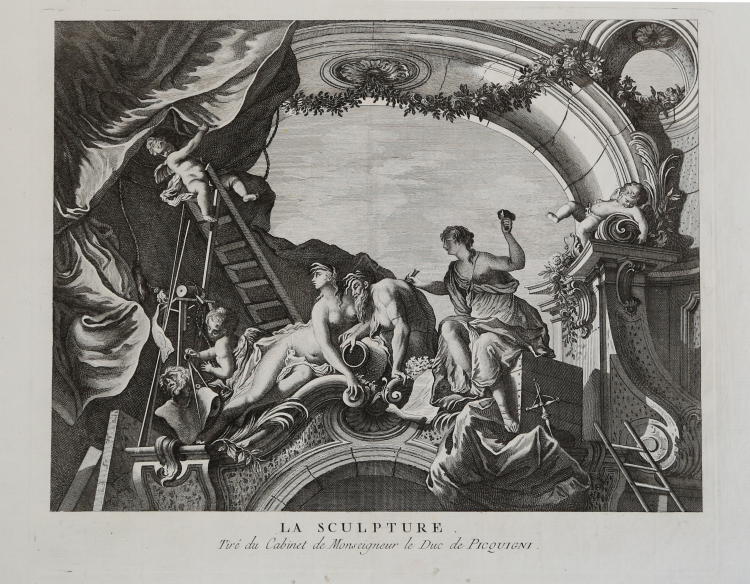



| Reference: | S1721 |
| Author | Charles Nicolas COCHIN |
| Year: | 1738 |
| Measures: | 370 x 305 mm |


| Reference: | S1721 |
| Author | Charles Nicolas COCHIN |
| Year: | 1738 |
| Measures: | 370 x 305 mm |
Etching and engraving after Jacques de Lajoüe.
A proof state, before the Chéreau address.
The present print is aa reproductive engraving after decorative paintings which served as supraportas in the natural history cabinet of Michel Ferdinand d’Albert d’Ailly, Duc de Picquigny and Fifth Duc de Chaulnes. Jacques de Lajoüe produced a total of thirteen paintings which were etched by Cochin, John Ingram and Nicolas Tardieu. The series of prints with depictions of the free arts and the sciences was published in 1738 by Chéreau’s widow and exhibited at the Paris Salon. In keeping with contemporary fashion during the reign of Louis XV, the illustration reveals a marked penchant for exuberant decoration. The alchemist clad in oriental dress is sat in a mysterious laboratory full of all manner of exotic stuffed animals, corals, vessels and artefacts that would
not be out of place in a seething witches’ kitchen.
The etching exists in two different versions, both of which bear the address of Chéreau’s widow. The prints in the series were immensely popular from the moment they were published. This evidently prompted the decision to issue a revised edition in order to meet the increased demand. In the first version the scene is framed like a trompe l’oeil to match the interior decoration in the cabinet of the Duc de Picquigny, whereas the illustration in the second version on offer here has a rectangular format and has been extended on all four sides to incorporate additional pictorial elements (see M. Roland Michel, Lajoüe et l’art rocaille, Neuilly-sur-Seine, 1984, pp. 329–330, 332).
A very fine impression with narrow margins, excellent condition.
|
Inventaire du Fonds Français, vol. 4, p. 635, no. 250; Michel G 71.
|
Charles Nicolas COCHIN (Paris, 29 Aprile 1688; Parigi, 16 Giugno 1754).
|
Engraver. He trained with his father, Charles Cochin, as a painter, but turned c. 1712 to engraving. In 1729 he was made an associate member (agréé) of the Académie Royale, and in 1731 he was received (reçu) as a full member. He was one of the best interpreters of Antoine Watteau, of Jean-François de Troy and of Jean-Siméon Chardin. He also contributed plates to a suite of engravings after Antoine Coypel for Don Quixote, and to the Recueil Crozat. From the 1740s he made engravings mainly after drawings by his son.
|
|
Inventaire du Fonds Français, vol. 4, p. 635, no. 250; Michel G 71.
|
Charles Nicolas COCHIN (Paris, 29 Aprile 1688; Parigi, 16 Giugno 1754).
|
Engraver. He trained with his father, Charles Cochin, as a painter, but turned c. 1712 to engraving. In 1729 he was made an associate member (agréé) of the Académie Royale, and in 1731 he was received (reçu) as a full member. He was one of the best interpreters of Antoine Watteau, of Jean-François de Troy and of Jean-Siméon Chardin. He also contributed plates to a suite of engravings after Antoine Coypel for Don Quixote, and to the Recueil Crozat. From the 1740s he made engravings mainly after drawings by his son.
|